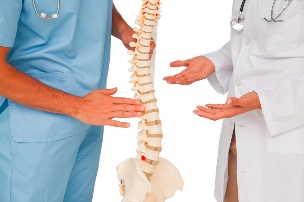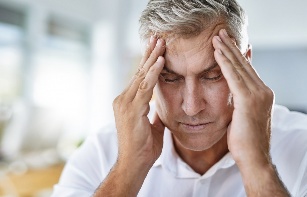
Many people associate the word "osteochondrosis" with old age. There is an opinion that this is a disease of grandparents, in which "shoots in the lower back" and "hurts in the back". However, there is only one grain of truth in this hoax: indeed, osteochondrosis isdegenerative(i. e. , caused by a local metabolic disorder)spinal changes, which inevitably appear in all older people. However, osteochondrosis is found today in 9 out of 10 people over the age of 45, and the first manifestations of the disease can begin as early as age 25.
This disease is even called"disease of civilization", as the main cause of osteochondrosis is improper "exploitation" of the spine. The fact is that a modern person is subjected to excessive loads, and, paradoxically, not when running or lifting weights, but when sitting down without getting up from the chair for hours. This load is calledstaticand is very complicated. Because a person thinks he is resting when he is sitting. But in fact, the spine in a sitting position functions with increased stress.
How the spine works
To understand what osteochondrosis is, you need to understand what the human spine is. We all know that the spine consists of vertebrae connected in series by the intervertebral discs. In total, a person usually has 33-34 vertebrae: 7 of them form the cervical region, 12 - the thoracic region, 5 (or 6 in a small percentage of people) - the waist, 5 more vertebrae, which growtogether, they form the sacrum and, finally, the coccygeal region consists of five (or four - depending on individual characteristics) vertebrae. The vertebrae are, in fact, bones and they are immobile, but in order to be able to move freely, providing mobility for our whole body, and also not to collapse from impacts and friction, there is a layer of gelatinous substance betweeneach bead (the so-callednucleus pulposus) surrounded by solid multilayered plates (anulus fibrosus). Collectively, this is called theintervertebral disc.In addition, the spinal structure contains numerous ligaments, vessels, nerves. This is a very complex organ that largely determines the work of almost all body systems, as it protects the spinal cord and affects its work.

The vertebrae and intervertebral discs are constantly renewed throughout a person's life. This is possible due to the fact that they are well supplied with blood and are always provided with good food. However, if, for some reason, food begins to flow to the spine in insufficient quantities, the pulposus nucleus loses its properties, the intervertebral disc becomes flatter and less elastic, cracks appear in the ring and the vertebrae themselves begin to move in the direction ofdifferent and approach each other. All this leads to a number of dangerous deviations - mainly ininflammation in both the spine and surrounding tissues, and up to compression of the spinal cord and spinal nerves.
interestings It is interesting that a concept such as "spinal osteochondrosis" exists mainly in the post-Soviet space. In the foreign literature, changes that occur in the spine are called"hernia", "myofascial pain", "disc damage", "dorsopathy". So if you have heard something similar about yourself, then you have spinal osteochondrosis. As forintervertebral hernia, it is considered to be one of the stages of osteochondrosis.
The disease does not have an acute course and develops gradually: first, the intervertebral disc narrows, changes degeneratively, then extensions appear- the zero of the nucleus appears to be squeezed and mixed with the fibrous ring, but does not break it. When there is a rupture of the anal fibrosus, they talk about an intervertebral hernia. In the last, most severe stage of osteochondrosis, the intervertebral discs are completely consumed, the vertebrae begin to rub against each other and also collapse, causing abnormal bone growth and osteophytes in them. In the final stage, the spine becomes "hardened", meaning it loses its mobility, which can lead to disability.
Causes of spinal diseases
Why do all the above degenerative changes occur?As already mentioned, the main reason isan abnormal load on the spine:for example, when a person has to sit too much in an uncomfortable, "bent" position, the regions of the neckuterus and chest experience tension and do not receive needed nutrition. In addition,osteochondrosis can develop due to poor behavior.However,sports, especially those with strength, in violation of training technique, can also lead todegenerative spinal changes.
Another common cause is anyback injury. The development of osteochondrosis can also be influenced by inherited genetic predispositions, hormonal disorders, overweight, unhealthy diet, insufficient water intake and, as a result, dehydration, smoking and alcohol abuse.
Women often encounter the first manifestations of osteochondrosis during pregnancy, when young mothers have to feed their baby in an uncomfortable position for themselves and often hold him in their arms, the condition of the spine deteriorates significantly.
Symptoms of osteochondrosis
The symptoms of osteochondrosis are varied and depend on the exact department in which the disorders occurred. Pain is the main manifestation of this pathology, however, whilering fibrosis ruptureis easy, it can be tedious, pressing, and patients may not even pay attention to it.Most often the pain intensifies in the morning or after a physical exertion, radiating to the arms, legs, neck, ribs and chest (in this case, osteochondrosis can be easily confused with coronary heart disease).
Furthermore,numbness and tingling sensation may occur in the limb.
With osteochondrosisin the cervical spine, you may experience headaches, sometimes very severe, dizziness, nausea, whistling in the ear. The development of a hernia, which leads to the suppression of nerve endings, can lead to disruption in the work of internal organs associated with the affected nerve. For example, with a hernia in the lumbar spine, problems with urination may appear, strength disappears, in the chest - indigestion, in the cervix - problems with blood supply to the brain.

Diagnosis of osteochondrosis
Only a doctor can distinguish osteochondrosis from other diseases of the internal organs and determine the source of pain. Today, the most reliable method for diagnosing spinal diseases is considered to be magnetic resonance imaging.
X-rays are also reliable, but less informative. In an X-ray image, you can see changes in the intervertebral discs, but you can not see, for example, a hernia and assess the condition of the spinal cord and the degree of its compression by the displaced vertebrae. In addition, MRI allows you to distinguish osteochondrosis from other dangerous diseases, including malignant formations and ankylosing spondylitis.
Is it possible to cure osteochondrosis?
Unfortunately, it is impossible to cure osteochondrosis, but it is possible to alleviate the patient's condition andprevent further destruction of the intervertebral disc, however, for this it is necessary tocompletely change your lifestyle - do physical therapy, swimming, take regular massage courses or manual therapy, start eating properly and give up bad habits. Exercise, massage, proper nutrition, and weight loss can have a significantly greater and longer-term healing effect than medication.
Doctors are still arguing about the effectiveness of chondroprotectors - drugs that restore cartilage tissue and supposedly strengthen anulus fibrosus, their effectiveness has not been proven enough, but since they certainly do no harm, they can be used to treatosteokondrozën.
For severe pain, your doctor may prescribe non-steroidal anti-inflammatory drugs (NSAIDs), muscle relaxants (analgesics), and analgesics.
Used in the treatment of osteochondrosis and vitamins, as their absence provokes further destruction of the intervertebral disc:B vitamins, for example, contribute to improving protein metabolismbetween tissues, and since protein is the main building material in the body, the normalization of protein metabolism contributes to the restoration of nerve and cartilage tissue. Vitamin A improves blood circulation. However, taking vitamins, like any other medicine, you need to be careful, as they can cause severe side effects, and they can only be taken after consulting a doctor and under his supervision.
Surgical treatment of osteochondrosis is also possible, but is usually directed when there issignificant narrowing of the spinal canal and excessive compression of the nerves and spinal cord by the resulting hernias. In this case, the situation is so difficult that the patient, for example, can not walk, his internal organs begin to fail, or there is a risk of developing a stroke. Most often, such serious consequences are caused by osteochondrosis of the cervical and lumbar spine, degenerative changes in the thoracic spine, even in the presence of hernias, almost never require surgical treatment.
todayThe device is inserted into the site of the spinal wound through small incisions in the skin, which avoids large blood loss. Since the entire disc is not removed during surgery, spinal biomechanics are usually not disturbed and this shortens the recovery period. Often, patients stand up within a day after surgery. However, any spinal surgery is still fraught with complications and subsequent recurrences of the disease, so experienced specialists will try to delay surgical treatment to the last. And here everything depends on the patients themselves: if they follow all the recommendations of doctors and take care of their health, then even in the presence of hernias, they will be able to do without surgery.
















































